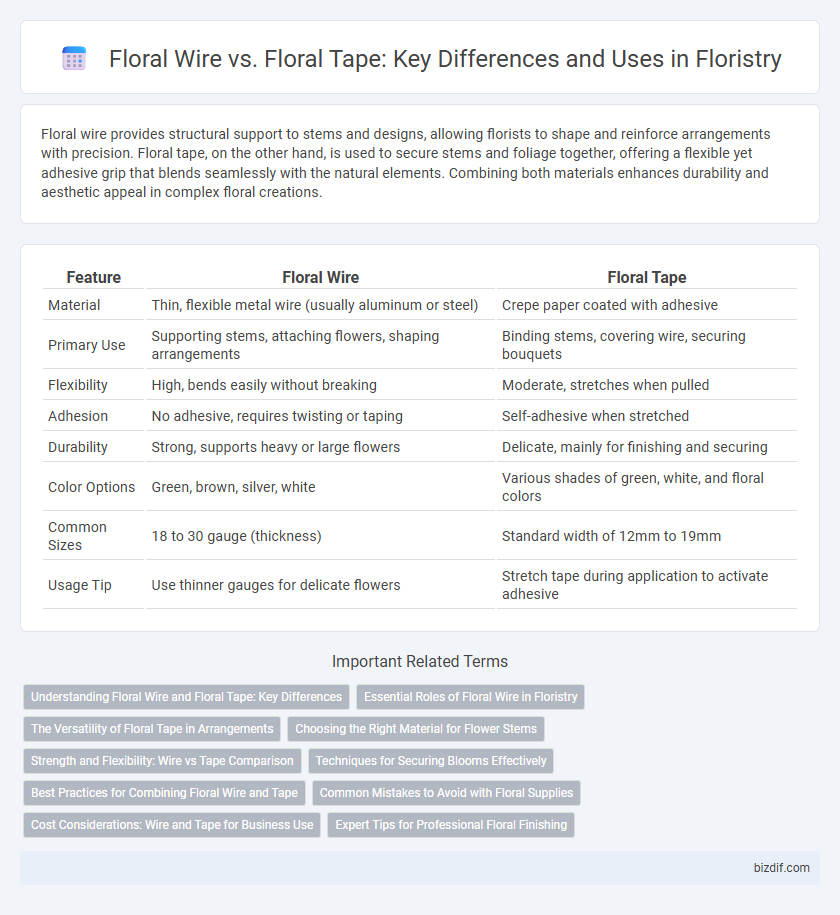Floral wire provides structural support to stems and designs, allowing florists to shape and reinforce arrangements with precision. Floral tape, on the other hand, is used to secure stems and foliage together, offering a flexible yet adhesive grip that blends seamlessly with the natural elements. Combining both materials enhances durability and aesthetic appeal in complex floral creations.
Table of Comparison
| Feature | Floral Wire | Floral Tape |
|---|---|---|
| Material | Thin, flexible metal wire (usually aluminum or steel) | Crepe paper coated with adhesive |
| Primary Use | Supporting stems, attaching flowers, shaping arrangements | Binding stems, covering wire, securing bouquets |
| Flexibility | High, bends easily without breaking | Moderate, stretches when pulled |
| Adhesion | No adhesive, requires twisting or taping | Self-adhesive when stretched |
| Durability | Strong, supports heavy or large flowers | Delicate, mainly for finishing and securing |
| Color Options | Green, brown, silver, white | Various shades of green, white, and floral colors |
| Common Sizes | 18 to 30 gauge (thickness) | Standard width of 12mm to 19mm |
| Usage Tip | Use thinner gauges for delicate flowers | Stretch tape during application to activate adhesive |
Understanding Floral Wire and Floral Tape: Key Differences
Floral wire provides structural support to stems and arrangements, offering strength and flexibility essential for securing flowers in place. Floral tape, typically a stretchy, adhesive-coated paper, is designed to bind stems and wires while concealing mechanics, creating a cohesive and polished look. Understanding the differences allows florists to combine wire's durability with tape's seamless finish for professional-quality floral designs.
Essential Roles of Floral Wire in Floristry
Floral wire provides structural support and stability to delicate stems, enabling precise shaping and secure attachment of flowers in arrangements. Its versatility allows florists to create intricate designs by reinforcing stems and anchoring blooms, which floral tape alone cannot achieve due to its adhesive and binding properties. Floral wire is essential for maintaining the longevity and integrity of complex floral compositions.
The Versatility of Floral Tape in Arrangements
Floral tape offers exceptional versatility in flower arranging by securely binding stems and creating flexible, seamless connections that floral wire alone cannot achieve. Its stretchable and adhesive properties allow for easy manipulation and concealment within bouquets, corsages, and wreaths, enhancing the overall structure and aesthetic. Unlike floral wire, which primarily provides strength, floral tape adapts to delicate flower stems, minimizing damage and ensuring a natural, polished finish.
Choosing the Right Material for Flower Stems
Floral wire provides essential support and structure for delicate flower stems, making it ideal for shaping and reinforcing arrangements. Floral tape, known for its adhesive and flexible qualities, is perfect for binding stems and covering wire to create a natural look. Choosing the right material depends on whether firmness or concealment is the priority in the floral design.
Strength and Flexibility: Wire vs Tape Comparison
Floral wire offers superior strength and structural support, ideal for securing heavier stems and shaping arrangements, while floral tape provides excellent flexibility and adhesive qualities to bind delicate stems without damaging them. Wire maintains firmness and can be molded into precise shapes, whereas floral tape stretches and contracts, ensuring a tight, seamless hold around floral materials. Choosing between wire and tape depends on whether rigidity or adaptability is required in the floral design.
Techniques for Securing Blooms Effectively
Floral wire provides firm support by holding stems in place securely, essential for structuring intricate arrangements and maintaining flower posture. Floral tape wraps tightly around stems and wires, creating a uniform and natural-looking bind that conceals attachment points while allowing flexibility. Combining floral wire and floral tape enhances durability and aesthetic appeal in professional floristry techniques for securing blooms effectively.
Best Practices for Combining Floral Wire and Tape
When combining floral wire and floral tape, use floral wire to provide structure and support for stems, creating a sturdy framework for arrangements. Wrap floral tape tightly around the wire and stem to secure connections and maintain moisture retention, ensuring a natural appearance. Best practices include stretching the tape slightly while wrapping to activate its adhesive qualities and layering it evenly for a seamless finish.
Common Mistakes to Avoid with Floral Supplies
Using floral wire incorrectly can cause stems to snap or flowers to wilt, especially when selecting wire that is too thick or too thin for the specific arrangement. Applying floral tape without properly stretching it to activate the adhesive often results in weak holds and unraveling over time. Avoid mixing floral wire and tape on the same stem without securing the wire properly, as this can lead to instability and damage to delicate blooms.
Cost Considerations: Wire and Tape for Business Use
Floral wire generally costs more than floral tape but offers superior strength and support for professional floral arrangements, making it essential for structural designs in floristry businesses. Floral tape is more affordable and versatile for wrapping stems and securing delicate blooms but lacks the rigidity needed for heavy-duty applications. Balancing cost efficiency and functionality, florists often use floral tape for finishing touches and floral wire where durability and stability are critical.
Expert Tips for Professional Floral Finishing
Floral wire provides essential structural support for delicate stems and intricate designs, allowing professionals to create stable, long-lasting arrangements. Floral tape, with its adhesive and flexible qualities, seamlessly secures wired stems while maintaining a natural appearance by blending with the greenery. Experts recommend using floral wire to reinforce fragile components before wrapping with floral tape to ensure both durability and a polished, professional finish.
Floral wire vs floral tape Infographic

 bizdif.com
bizdif.com